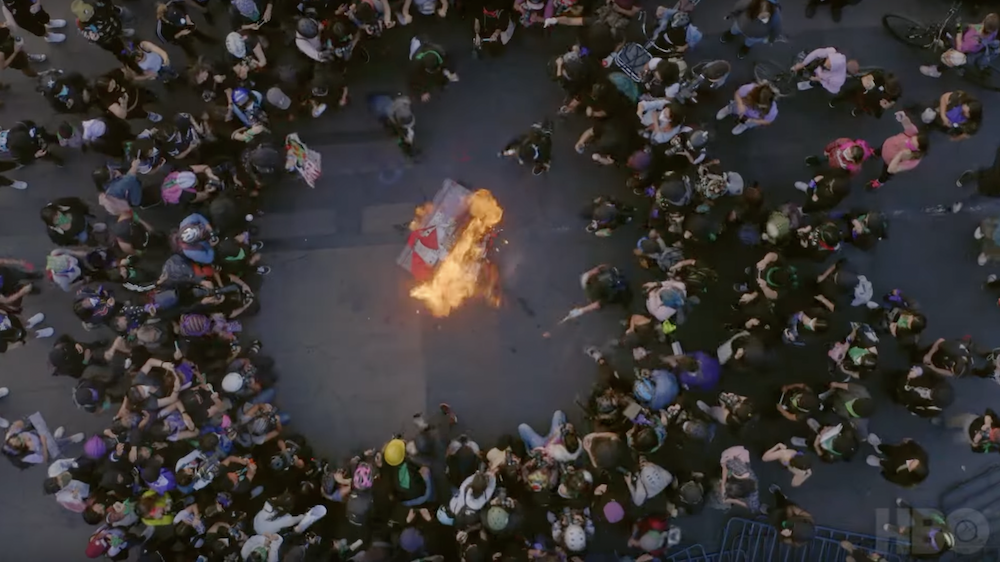Democracy dies in darkness. But it also suffers in silence. The multiple ways in which this happens is the subject of the new HBO documentary Endangered.
Co-directors Heidi Ewing and Rachel Grady are no strangers to difficult subject matter. In the course of their filmmaking careers, the pair have taken on a number of stories from abortion (12th & Delaware) to religious fundamentalism (Jesus Camp). In Endangered, the directors follow four journalists around the globe to fashion a portrait of what happens when the truth is actively suppressed, if not outright strangled.
It’s not pretty.
The idea that journalism is under attack isn’t a revelation. In many parts of the world, being a media worker is a very dangerous profession. High-profile murders, like those of Jamal Khashoggi and more recently Dom Phillips, have snared global attention. But the death toll for journalists around the globe has been grim for years.
In spite of the stats and brimming tide of violence, Endangered is not a hopeless film. The courage, perseverance and remarkable professionalism embodied in each of the four people profiled is a reminder that the Fourth Estate is a critical part of a healthy society. But increasingly, holding power to account comes at a significant cost.
The cost of being fearless
Endangered puts a human face to the requirements of the job. In Brazil, Mexico and the U.S., the reporters and photographers featured in the film balance the demands of work with family, kids and partners. Even in less fraught times, this wasn’t easy. As photojournalist Sáshenka Gutiérrez explains, the job doesn’t pay very well, it’s exhausting, but the reason she does what she does is because it matters.
In Mexico, an estimated 3,600 women are killed every year. With her bright purple hair, Gutiérrez makes for a highly visible target as she puts herself directly into the heat of the action, documenting protests about the war on women, as activists and ordinary folk square off against the police.
Mexico is one of the deadliest countries in the world for journalists with attacks on the press increasing by 85 per cent since President Andrés Manuel López Obrador took office.
While the murders of many high-profile reporters have focused attention on the larger situation, Endangered brings the reality of home.
After a day of documenting the forces of oppression and state violence, Gutiérrez heads back to her modest apartment to have a beer and a moment of quiet conversation with her partner, before getting up the next day and doing it all over again.
As she dons a helmet, goggles and other protective gear, the threat of harm hangs heavily in the air. When the police break out riot shields and truncheons to beat back the tide of protesters, Gutiérrez keeps taking photographs, even as she’s overcome with tear gas. This kind of raw courage is stunning to witness. As she says, “My mother taught me not to be afraid to tell the truth.”
In Brazil, the threats are no less frightening, even without direct physical confrontation. When Patrícia Campos Mello, a reporter for the Folha de São Paulo newspaper, uncovered election fraud in Brazil, she entered into a war of words with Brazilian President Jair Bolsonaro.
In a television interview, Bolsonaro quipped that Mello traded her hole for a scoop, intimating that she’d had sex with an informant in exchange for intel. As Mello says in an interview in the documentary, “To half the Brazilian population, I am a whore who trades sex for information.”
Even as her father cautions her about not getting into trouble, Mello sues the Brazilian president for slander.
Although the outcome for Mello was a positive one, legal threats against journalists have become another means of quashing criticism, as the recent libel case against the Guardian’s Carole Cadwalladr indicates.
It isn’t always a full-frontal assault on individuals. Sometimes it’s a slow death by bits and pieces of an entire system.
As community newspapers continue to disappear in small towns across North America, the stories local reporters cover also vanish. These news deserts are spreading as publications continue to wink out, the victim of older outdated media models, but also of readership turning to more silo-minded means of getting information.
It’s not only smaller papers that are under threat. After the Miami Herald was bought by a hedge fund, it shuttered its newsroom as a cost-cutting measure. Herald photographer Carl Juste, who has worked at the paper for 20 years, explains how a functional press is vital in many different ways.
While covering Black Lives Matter marches in the U.S., Juste’s photos proved that the police were not telling the truth about their actions during protests. As he says in the film doing journalism the right way takes people, time and money. All of these are harder to come by in the current media landscape.
There are other threats as well, as the Guardian’s Oliver Laughland, reporting from the reddest reaches of MAGA country, discovers. In the documentary, Laughland’s attempts to interview Trump supporters are both harrowing and darkly funny, as people either refuse to answer questions or spout the rhetoric they’ve gleaned from Fox News and YouTube videos. When asked where she’s getting her information from after the local paper shuts down, one woman says, “I’m not going to buy a newspaper that doesn’t reflect my views.”
But these more comic bits turn ashen when, at a Trump rally, the former president incites his followers to turn and vent their rage at the reporters and journalists covering the event.
The perils of speaking the truth have always been high, but they are positively vertiginous at the moment. Nothing makes this more apparent than the section in the film dedicated to the ravages of the global pandemic. When COVID-19 began to decimate Mexico City, politicians and senior medical professionals maintained that the mortality rates were nothing to be worried about. The country’s president even offered a televised speech where he downplayed the seriousness of the disease, saying that people still needed to hug one another.
Some of the only people telling the truth were nurses, who spoke out about the almost 90-per-cent mortality rates for COVID-19 patients. As the women tell photojournalist Sáshenka Gutiérrez about what is really taking place inside the city’s major hospitals, the stakes become explicitly evident.
In addition to the four journalists profiled, the film dedicates attention to the Committee to Protect Journalists. The organization convenes media workers from around the world to talk about what is happening in their individual countries. While battles in Russia and Pakistan against the press are well-documented, it is the American journalists who are most unprepared for surveillance of their work, as well as more direct attacks.
Destruction of a free press and the rise of neo-fascism
Academy-award winning filmmaker Laura Poitras also examined the technologies that are increasingly brought to bear against journalists in her film Terror Contagion as cyber weapons of war are used against media workers. It’s not only politicians and world leaders who are undermining and suppressing information, but corporations as well.
As Endangered makes clear, the destruction of a free press is linked to the rise of autocrats and neo-fascism. It’s only a few steps from presidents calling journalists the enemies of the people to outright violence. The apotheosis of this fire-stoking exploded in the U.S. Capitol on Jan. 6, 2021. In the documentary, scenes of the insurrectionists smashing cameras and media equipment have lost none of their shock value.
The film’s executive producer Ronan Farrow is no stranger to stories getting squashed. Farrow’s reporting on the Harvey Weinstein scandal was allegedly pulled by NBC before finally being published in The New Yorker. In the course of his investigation, Farrow was under constant surveillance as well as facing ongoing threats of legal action.
This kind of active suppression is only one aspect. Endangered speaks to an even more troubling development, namely, the purposeful muddying of truth with opinion or, worse, conspiracy theory. This conflation has led to a culture where some people have decided that reality is something that can be either willfully altered or completely ignored.
While social impact documentaries like Endangered continue to tackle complex issues, this type of film is still a relatively niche genre. The people who probably most need to see the film are the least likely to do so. How to reach people who have willfully turned away from reality and into rage-soaked aggrievement is the lingering question. It has equal relevance in Canada as the attrition of media outlets has impacted what stories are told, as well as what stories aren’t.
The winnowing down to irrelevance or extinction of reported news does not bode well for any human society. But ultimately, it is the ongoing examples of daily courage of the different writers and photographers in the film that resound. In the face of physical threats to themselves and their families, they do their jobs, showing up at political rallies, getting between riot squads and protesters, asking the hard questions and documenting events as they happen.
At a Bolsonaro rally, a supporter of the Brazilian president calls for the murder of the free press. “These reporters are criminals! These people need to be exterminated!”
After the rally, reporter Patrícia Campos Mello returns home to her young son, makes dinner and chats with him as they eat. It’s a small and yet piercing reminder of the human cost of telling the truth. ![]()
Read more: Rights + Justice, Media, Film

















Tyee Commenting Guidelines
Comments that violate guidelines risk being deleted, and violations may result in a temporary or permanent user ban. Maintain the spirit of good conversation to stay in the discussion.
*Please note The Tyee is not a forum for spreading misinformation about COVID-19, denying its existence or minimizing its risk to public health.
Do:
Do not: